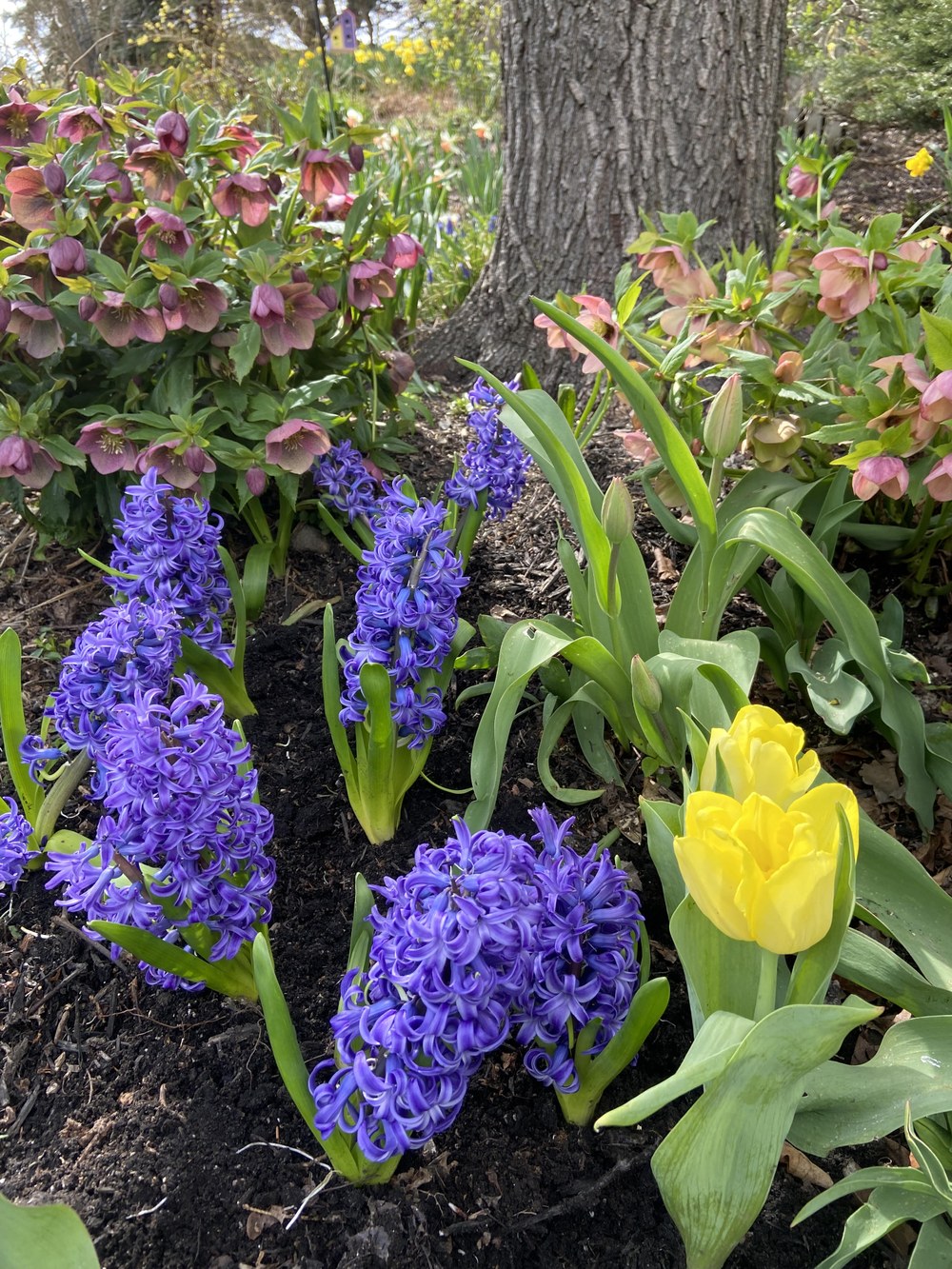Posted: April 29, 2022
April is one of my favorite months of the year. The days become longer, the temperatures are typically in the 60’s and 70’s, and we are blessed with April showers. The birds serenade one another, and the peepers provide a chorus of chirping to welcome spring. After seeing the whites, grays, and browns of the winter months, a masterpiece of color is displayed in April.

Spring bulbs and Perennials combination
All the hard work of planting spring bulbs in the fall will come to fruition when the beautiful colors of daffodils, hyacinths, allium, crocus, dwarf iris, grape hyacinths, and tulips make their appearance.
Narcissus is a genus of predominantly spring flowering perennial plants of the Amaryllis family, Amaryllidaceae. Various common names including daffodil, narcissus, and jonquil are used to describe members of this genus. Daffodils are a popular spring bulb that has many varieties and are easy to grow. A legend about daffodils flows from the famous Greek mythology about a handsome youth named Narcissus. Once, while Narcissus was hunting in the woods, a wood nymph named Echo saw him from her hiding place behind a tree. He was so handsome, and she fell desperately in love with him. Unfortunately, Narcissus refused the advances of Echo. The lovely nymph, heartbroken, wastes away and dies with only her voice remaining to echo her plight. The goddess, Nemesis, heard about poor Echo and lured Narcissus to a shimmering lake. In his vain state, Narcissus was unable to resist gazing at his own reflection, and fell in love with himself. As he gazed, his divine penalty took effect, and he simply faded away. In his place sprung up the golden flower that bears his name today.
Because of the wide variety of spring bulbs, a greater impact is attained if the bulbs are planted in groups of the same variety. Different varieties of tulips bloom in early spring, mid spring, and late spring and therefore make a lovely succession of blooms. When creating a mix of flower bulbs, freely experiment with color combinations.
As the green foliage of the spring bulb plants begin to turn yellow, it is very important not to snip the stems and leaves until they die back naturally, which can take several weeks. The yellowing leaves are a signal that the plant is going dormant for the summer. Flowering bulbs need their leaves to photosynthesize and make food after they finish blooming. The bulbs must store enough food to not just get them through the remainder of the year, but also to set new buds for the following spring.
Spring herbaceous perennials planted among your bulbs help create an attractive diversion by hiding the dying bulb foliage with fresh growth. Not only is April a great month to enjoy spring bulbs, it is also an appropriate month to plant hardy, spring-blooming perennials. The best selection will be found in greenhouses and nurseries in April.
To obtain the best result when combining spring bulbs and perennials, consider each plant's color, bloom season, and height to find plants that complement one another. Remember that all the plants won't be in bloom at the same time, though some may overlap, so keep in mind how foliage of the various plants will look together. Also, harmonize the bulbs and perennials with consideration to their sunlight and water requirements.
Two of my favorite spring perennials, Hellebores (Helleborus) and Brunnera (Brunnera macrophylla), partner very well with spring bulbs. They both prefer part shade. The foliage of the Brunnera is exquisite and Hellebores have evergreen foliage and a variety of early and mid-spring blooms from which one can choose. Other springtime herbaceous perennials to consider are Dianthus (Dianthus), Columbine (Aquilegia), Bleeding hearts (Dicentra spectabilis), Creeping Phlox (Phlox subulate), Penstemon 'Husker Red' (Penstemon) and English Daisy (Bellis perennis).
Summer perennials with beautiful texture and foliage will complement the spring plantings even though their flower bloom has not appeared yet. Coral Bells (Heuchera) have a vast variety of blooms and foliage which complement spring and summer bulbs. Some native summer perennials to consider are Yarrow (Archillea millefolium), Bee Balm (Monarda), and Coreopsis (Coreopis).
Personalize your garden by choosing spring bulbs and perennials with bloom colors, leaf variations, and fragrances that you enjoy. Every garden is unique to its owner. Enjoy creating a spring landscape of beauty that you and others will appreciate and look forward to each year.
Upcoming Workshop - 'Wellness in the Garden' Join us from 11 - 2 on Saturday, May 21 for yoga, qigong, plants for wellness, tea tasting, light refreshments, and a garden tour. Visit the Workshop website for more information and to register.
Monday videos: Visit us on Facebook, Instagram and TikTok at Penn State Master Gardeners in Adams County for our Master Gardeners' Monday Videos. Timely and relevant topics will be discussed on a weekly basis keeping readers up to date on current horticultural issues.
Master Gardener Hotline is open April through September, on Mondays, Wednesdays and Fridays from 10am - 2pm. Master Gardeners can take your samples on Mondays and Fridays. Please send an email (with pictures if possible) to adamsmg@psu.edu with your gardening questions, or stop by Penn State Extension, 670 Old Harrisburg Road, Gettysburg.
Carolyn Black is a Penn State Master Gardener from Adams County. The Penn State Cooperative Extension of Adams County is located at 670 Old Harrisburg Road, Suite 204, Gettysburg, phone 334-6271.

